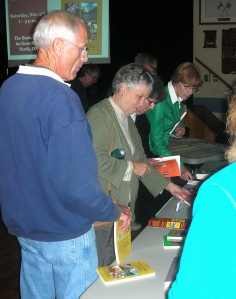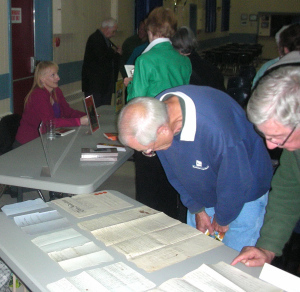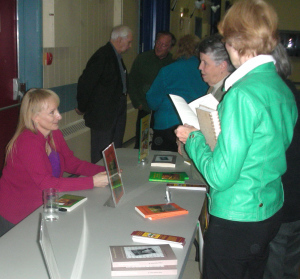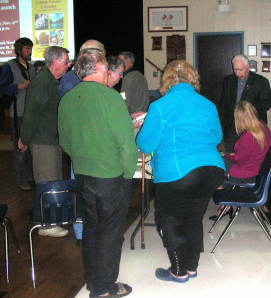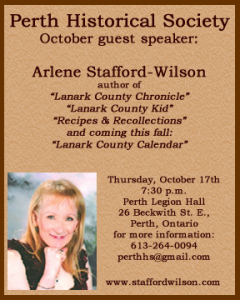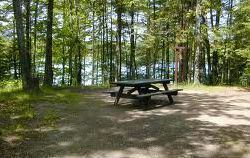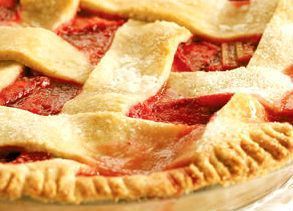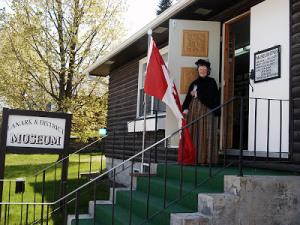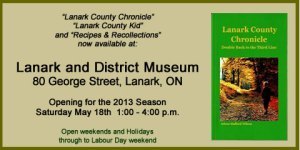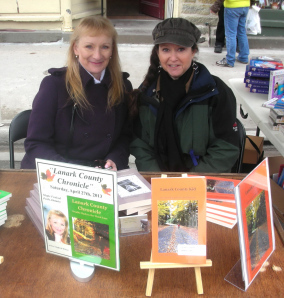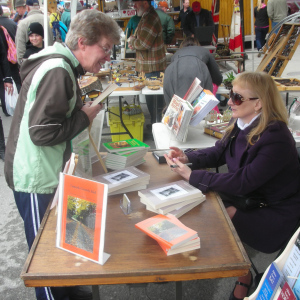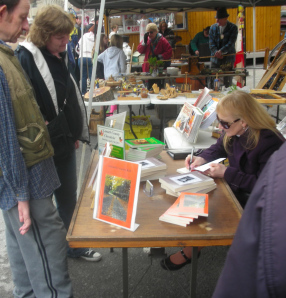Arlene Stafford-Wilson's Blog, page 58
October 19, 2013
Guest Speaker – Perth Historical Society Oct. 17 2013
Many thanks for the warm welcome I received from the members of the Perth Historical Society last Thursday, October 17th. It’s always nice to be back in Perth, and in particular to be back at the Perth Legion, a place dedicated to preserving the memory of our Canadian war veterans. (My mother, Corporal Audry (Rutherford) Stafford met my father Sergeant Tobias ‘Tib’ Stafford at the No. 8 Bombing and Gunnery School on the Air Force base in Lethbridge, Alberta in 1943, and both were proud members of the Legion in Perth.)
I began my presentation with some tips on conducting interviews with family members and recording our family stories to pass down through the generations. Next, was a discussion of some of the early families who settled in Drummond Township following the War of 1812. I presented an overview of life in Lanark County in 1928 leading up to a reading of ‘The Cattle Drives of Ferguson Falls’, an excerpt from my third book ‘Lanark County Chronicle’. It was my cousin Thomas Stafford who participated in the cattle drive and he shared his story with me.
It was a privilege to meet so many people who shared a keen interest in the history of Lanark County and of Perth in particular. I was fortunate to meet distinguished Perth historian Mr. Gus Quattrocci and share a few moments with him. It was particularly special to re-connect with Mr. David Crowley, my former Principal from my years at Glen Tay Public School. A special thank-you to John, David and Barrie of the Perth Historical Society who assisted with our audio-visual set-up. What an enthusiastic trio of historians! It was a pleasure to meet them!
I would like to extend a special thank-you to my cousin Thomas Stafford who provided the entire collection of documents displayed on the presentation table. Thomas lent us the complete paper-trail of the Doyle family homestead in Drummond Township from the 1820 original land grant on calf-skin with a wax seal from Lord Simcoe. The documents showed the land transfer from William McGrath to Joshua Dobson in 1822 then to Martin Doyle and Ellen Walsh in 1861. This included deeds, mortgages and all related paperwork. Many stopped to examine the papers following the presentation and it was an honour to share this wonderful display of our early history.
I was pleased that many of my first three books were purchased at the book table and that I was able to sign and personalize them. It was the perfect occasion to announce the launch of my fourth book which will take place at The Book Nook, 60 Gore St., Perth, on Saturday, Nov. 2nd between 1 and 3 pm.
Thanks again to the Perth Historical Society and other visitors for their warm hospitality and to allow me to spend such an enjoyable evening with them!


September 29, 2013
Perth Historical Society – October 17th, 2013
September 1, 2013
A Change of Seasons
“Where are those birds going?”, I asked, squinting up at the bright September sky, from my vantage point in the vegetable garden. I sat cross-legged between two rows of tomato plants, the earth still warm from the late summer sun, shielding my eyes with my hand, straining to see the last few stragglers as they flew over Korry’s barn and out of sight. It was the second flock I’d noticed that day, another noisy procession, in a big ‘v’ shape, flying from behind the house, over our yard, and across the Third Line.
“They’re heading south.” Mother responded without looking up. She was busy filling her plastic mixing bowl with tomatoes; picking the softest, reddest ones and leaving the hard, little, green ones on the vines. She was on a mission these past few days to harvest as much as we could from the garden and preserve it all in glass mason jars before the frost hit.
“Why are they going south?”, I questioned. I was always asking questions and wondered to myself what it was like to be grown up and have all the answers and to understand how everything worked in the world.
Mother stopped for a moment and set her bowl on the ground, realizing that I wasn’t going to be satisfied with a short answer. She went on to explain that when the snow came and covered the ground that the birds wouldn’t be able to find any food, so they had to fly south where it was sunny and warm all the time.
Sunny and warm all the time? With no snow? Why doesn’t everyone go there? I had so many questions that I didn’t even know where to begin. While I was busy thinking my way through this new information, Mother had picked up her bowl and moved to the next row.
I got up, dusted the dirt from my clothes and ran into the house. If the birds were going south today, then so would I. I ran up the back stairs where we kept the suitcases. I picked up a small one that would be easy for me to carry and lugged it up the main stairs to my bedroom. I grabbed some tee shirts and shorts out of my drawer and placed them in the suitcase.
What else should I pack? I would need some food for the trip. I ran downstairs and into the pantry and took a cookie tin off of the shelf. I grabbed a brown paper bag out of the drawer and placed four chocolate chip cookies inside. I took one of the new mason jars from the shelf in the pantry, filled it with milk, twisted the lid on tightly and put it into my suitcase. I was ready to go south.
I carried my little brown suitcase out to the garden, over to where Mother was working, and announced that I would be going south with the birds. I suppose that after having raised four children before me, she’d heard it all and she merely nodded, smiled and kept on working.
The two flocks of geese that I’d seen that day seemed to be coming from the side road behind the house, so I decided that I’d head back there, find a flock that was ready to leave and join them. The fact that I didn’t know how to fly hadn’t really registered in my five-year-old mind at that point and I hurried down the lane, turned left and headed down the dirt road, toward the Fourth Line.
I passed the little creek where I’d watched the tadpoles in the spring. I set my suitcase down and peered past the opening of the culvert. There was hardly any water passing through at all; not like the wide stream that rushed through just a few months before. There was only a narrow trickle running under the dirt road and out the other side of the big metal pipe into the lowlands.
No wonder the birds were leaving. The water was drying up, the wild flowers were turning to seed and the sun was sliding down behind Mitchell’s barn a little earlier each evening.
I continued to walk until I reached the railroad tracks. I hadn’t seen one flock of geese since I left home. I climbed the grassy hill beside the tracks, dragging my suitcase until I reached the top and sat down, leaning against the big maple tree, shaded from the sun. I decided to eat the lunch that I’d packed and I unzipped my suitcase and pulled out my bag of cookies and jar of milk. I finished the cookies, drank the milk, and put the containers back in my case.
I leaned against the tree and waited. I saw a few birds darting in and out of the trees nearby, a couple of squirrels and even a curious chipmunk that sat up on his hind legs staring at me for a few seconds before scampering away. I didn’t see any geese; not one goose, let alone a flock of geese. Maybe I was too late. Maybe they’d already left. Maybe that was the last flock going south that we saw from the garden today. I sat there and waited…and waited…and waited.
I heard a voice in the distance calling, “Co-boss! Co-boss!”. It was a familiar sound that I heard each evening around seven o’clock when our neighbour on the next farm gathered his heard from the pasture and brought them back to the barn for milking. The sun was sinking lower in the sky and I knew it would be dark soon. I didn’t want to be outside all night by myself so I picked up my little brown suitcase and climbed down the hill, back up the side road, up the lane and into our yard just as the last sliver of red sun was disappearing below the horizon.
I opened the old wooden door that led into the kitchen and set my suitcase down on the rubber mat. Mother heard me come in and called from the living room, “Are you hungry? I kept your supper warm in the oven.” I felt defeated. I didn’t want to tell anyone that I had failed to meet up with a flock of geese and join them on their trip south. The birds had all left for the season and I was stuck here with the cold and snow. They would have sunny days and warm weather and I would be walking on chilly floors in the drafty old house, too cold to play outside.
Looking back on that day, so many years ago, I realize that I was wrong about a couple of things. I realize now that I was wrong to think that I could simply pack a suitcase and join with a group of birds in their southern migration. The second thing was thinking that it was better to be grown up and understand how the world works. Yes, we grow older and ‘wiser’, but in doing so we lose much of our innocence. We stop believing that anything is possible and replace our enthusiasm with all of the reasons why we can’t do something.
At this time of year, when the days grow shorter and the geese fill the skies overhead with their familiar chorus I like to remember a little girl who packed her bag and left the security of home, ready to join the flock on their journey. That little girl didn’t tell herself that she couldn’t fly or that the birds might not want her to come along. She made up her mind, grabbed her bag and headed back the side road.
Remembering that day makes me wonder what each of us could accomplish if we stopped listening to the grown-up voice telling us all the reasons why we can’t do something. What if, even once in a while, we listened to the voice of the child inside of us telling us that we can?’


August 18, 2013
Mrs. Conboy: An Iron Fist in a Velvet Glove
It was nothing short of a miracle that Mrs. Conboy managed to keep her sense of humour in our rowdy often boisterous classroom at Glen Tay Public School. After all, she had some of the most ‘lively’ boys in the entire building nestled snuggly at the back of her classroom. They all seemed to sit in a tight cluster at the far left side of the six neatly-spaced rows that ran from front to back, close enough to the windows for them to become distracted more often than not.
I often wondered if that was why they had chosen Mrs. Conboy to be in charge of some of the oldest and most challenging characters in the shiny new school, a building barely four years old at the time. The powers-that-be had decided in their questionable ‘wisdom’ to close down all of the one-room school houses in Lanark County and to bus us all from near and far to the modern, gleaming school on Harper Road.
So there she was, not a particularly tall or imposing lady, but one with enough of a serious nature, tempered with a quick smile that managed to keep order in a class of almost forty students. Many of her charges were large, strapping, farm lads, with high levels of energy that might have been better served in a sunny open field, than trapped inside four closed walls, so far from their homes and waiting chores.
I don’t think I have ever played as much softball before or since, as I did that year in Mrs. Conboy’s class. She was wise enough to know when the activity level in the classroom had gone beyond an environment suitable for learning and she’d announce that we’d be taking a break from our lessons to play a game of ball. Off we’d go outside to the ball diamond at the back of the school, carrying balls, bats and gloves. Sometimes we’d play for just half an hour, sometimes an hour or more and I think it all depended on Mrs. Conboy’s calculations of just how much pent up energy needed to be burned off before returning to class.
When she wasn’t keeping order in her classroom or acting as an umpire at our frequent softball games Mrs. Conboy was an excellent teacher. Standing at the front of the class, beneath the portrait of Queen Elizabeth II, she managed to convey to us the finer points of English grammar, how to construct a decent poem, and maintaining good cursive writing skills so that our long-hand would not be mistaken for that of a doctor’s.
She also taught History and managed to bring some of the characters from the past back to life again in her colourful descriptions. Her lessons were always sprinkled with some of her own slant on the facts and a bit of her own brand of common sense thrown in for good measure. She was not afraid to toss her own opinions into the mix, nor did she hesitate to ask us for ours. Nothing seemed to please her more than to get a good debate going in the classroom and she encouraged our participation and challenged our arguments.
Above all, Mrs. Conboy understood children. She knew when it was time to sit and learn and when it was time to get some fresh air and burn off some energy. She knew how to calm down the rowdy boys with a mixture of a stern tone and a smile that never seemed to completely leave the corners of her mouth. She inspired us to be the best we could be and to go out into the world and be good citizens and to make a contribution to our communities. She gave us the tools to accomplish our goals and expected no less than excellence.
If we’re lucky in life, we can all name a teacher or two like Mrs. Conboy who made a lasting impression, who stays in our fondest memories and whose voice we hear reminding us that if we work hard we can achieve our goals. A teacher need not be a Harvard professor, or an Oxford scholar to make a lingering impression on a child. A good teacher needs to understand that not all education comes from a book but can come from a sunny day on a baseball diamond sharing laughter and developing friendships and social skills. Mrs. Conboy, like other great teachers leaves a lasting legacy, as we, her students from so long ago; continue to be inspired to always do our best. Mrs. Conboy, you will not be forgotten.
(This post is in memory of: Dencie Ellen (Tryon) Conboy,
July 02, 1922 – July 21, 2013, Retired Elementary School Teacher)


July 22, 2013
Silver Lake Sundays
Silver Lake Sundays
It always seemed as though Highway 7 was busy, cars and trucks rushing along, especially on the weekends and even more so during the summer months. According to Dad, it wasn’t just the local people travelling between Perth and Sharbot Lake, but all the tourists that rambled along the Trans-Canada Highway doing a little sight-seeing and exploring the countryside. Whatever the reason, Highway 7 was busy as usual that Sunday afternoon so long ago, as we made our way to Silver Lake.
Although it was just a twenty minute drive from the old house, the ride seemed to take forever, our legs sticking to the hot vinyl seats in the back of the Buick, long before the days of air conditioning. It wasn’t until I saw the signs for the village of Maberly that I breathed a sigh of relief, knowing we’d be there in just a few more minutes. Dad flicked on his signal, I felt the car slow down and we turned and drove up the hill to the entry booth at Silver Lake Provincial Park. The park worker came over to the window, Dad showed his seasons pass and he waved us through.
Dad found a spot close to the picnic area and we drove in and parked the car. That was the easy part. The tricky part was finding just the right picnic table. Dad liked a table to be in the shade. Mother preferred a place with a little sun. Dad said he needed to be out of the wind so he could light his little green Coleman stove. Mother liked a breeze to keep the bugs away. So the hunt for the best table usually took a little longer, sometimes a lot longer than it should have. After all, we just wanted to cool off in the water and that beautiful lake stretching out ahead of us, sparkling in the sun, was all we could think about. Who cared where we ate supper?
The hunt for the perfect table continued. Should we use one of the tables under the shelter in case it rained, or maybe one of the ones farther up the hill, off by itself? There was a good table close to the main beach, but there were a bunch of rowdy people sitting at the table right next to it and Mother wondered aloud if that’s why no one else was using it.
They finally spotted a table halfway up the hill, toward the lower beach and sent one of us up the ridge to ‘save’ it. Dad opened the trunk and we each grabbed something and made our way up to the table. The table cloth, Coleman stove, cooler, plastic cups and plates, paper napkins, transistor radio, saucepans and cooking utensils were all brought to the site. We hauled the picnic gear up the slope and set it all down on the seats while Mother spread out the red plastic table cloth. It wasn’t until we placed the big cooler on the table that we noticed that the table rocked back and forth. Good grief! I hoped to myself that we wouldn’t have to pick another table! Dad got the boys to lift one end while he lifted the other and repositioned it until it was stable. What a relief!
While Mother took everything out of the cooler Dad turned on his portable radio, extended the antenna and went about setting up his little green metal stove. I grabbed a towel from the top of the cooler and headed down to the beach, finally free to jump in the lake and get cooled off. As I got closer to the beach, the noise and laughter from all of the kids grew louder and I could see people jumping off of rubber rafts and throwing beach balls around and some little kids were filling up sand pails and making sand castles along the shore.
I stepped cautiously into the shallow water along the sandy shore and it felt cool. Because I was right in the center of the main beach I got splashed again and again by the other kids running in and out and jumping nearby. I walked out slowly, up to my knees and then finally plunged in all the way and the water didn’t seem cool anymore; it was just perfect. There was a kid close by with a diving mask on and another kid with a fancy inflatable raft and he was gliding along the surface using his hands to propel himself. I wondered what it would be like to have these expensive gadgets to play with in the water. We had an old beach ball that kept shrinking because it leaked air and that was about it. Oh well, it was fun to splash around and cool off just the same.
I put my face in the water and opened my eyes. The bottom was sandy with some smooth pebbles and a couple of snail shells. There were some tiny minnows darting around and lots of arms and legs of kids playing nearby. I pulled my face back out of the water, took a deep breath and propelled myself down to the bottom pushing the water back with my arms, moving farther from the beach. When I felt myself running out of air I resurfaced, rubbed my eyes and looked back at the beach. There were lots of parents relaxing in lawn chairs, watching their kids swim. Little kids were playing close to the shore and bigger kids were splashing around, squealing, laughing and the bright July sun gleamed and glistened on the surface of the water.
I played in the water for hours, bobbing at the surface, swimming along the bottom, jumping into the gentle waves and floating on my back and kicking my feet, then gliding backwards, staring up at the bright sun and the blue sky. I watched as new kids came into the water and other kids left the beach, heading over to the playground past the parking lot. By the time Mother came down to the beach to call me for supper I’d had plenty of time to swim, my fingertips were wrinkly and I was ready to come out of the water.
As we walked up the path to the picnic table I began to smell the gas from the Coleman stove and the savoury scent of the hot dogs and I began to realize how hungry I was. The fresh corn was already boiled and stacked on a tray. There was a bowl of baked beans, a homemade potato salad, some devilled eggs, homemade rolls, pickles and a jellied salad. Everything tasted good, partly because I was hungry from swimming, but mostly because we were outside. Things always seemed to taste better outdoors in the fresh air for some reason. Dessert was Mother’s lemon squares. There was also a cookie tin of brownies and some butter tarts. No one went hungry at our picnics; that was for sure.
After we’d finished and cleaned up, we decided to walk across the road to Barbary’s store. The traffic was very busy on Highway 7 so we had to wait quite a while until both lanes were clear and then walked quickly across. The store was huge and they had everything – groceries, camping gear, water toys, even life jackets; anything that you might need if you were camping or visiting the lake. They had lots of souvenirs, postcards and knick-knacks for tourists. Dad asked me if I’d like a chocolate bar, but I’d spotted something even better. The store carried Partridge Family bubblegum cards and I was collecting them so I asked if I could have those instead. Dad agreed and bought me those and bought chocolate bars for everyone else and he also picked up a fly swatter that he’d spotted hanging up by the cash register. We left the store and once again waited a while until the road was clear and walked quickly across. We strolled up the hill to the park entrance, through the gates, past the washrooms and change rooms, down the hill through the parking lot and back up to the picnic table. We each picked up something and headed down the hill to the car and packed everything back into the trunk.
Once the car was packed, we went for a walk along the smaller, quieter beach on the other side of the picnic area. It was more peaceful at that beach and there were only one or two kids with their parents down near the water. As we walked along I picked up some smooth stones and a couple of snail shells to bring back home. The early evening sun was lower in the sky, but still bright and it bounced and played off of the water and shimmered through the trees along the shore. The air was fresh and clean and carried with it the soft scents of the lake and the nearby trees.
Many Sunday afternoons were spent at Silver Lake. There were no splash pads or giant water slides. We swam without water wings. Our only concern was how fast we could get into the lake to swim and not how we looked in our bathing suits. The old car had no air conditioning and our entertainment at supper consisted of a small transistor radio. If we wanted to call a friend we had to wait ‘til we got home and hope that none of the neighbours was using the party line. We filled our dinner plates time and again, stuffed ourselves with desserts and never counted a single calorie. We didn’t send text messages; instead we talked to each other and shared a few laughs.
Although there have been many useful advances in technology since those days, I will always treasure our simple summer picnics. I yearn for the clear water, the beach-scented air, and quiet walks along the sandy shores. I miss the shrieks of genuine laughter and carefree splashing in the warm waves. I dream of the distinctive smell of the Coleman stove and the unmistakeable flavours of the homemade comfort foods. Most of all, I long for the effortless, unguarded conversations that we shared between bites. Surely in today’s hectic, stressful world, hard-wired to the internet, constantly connected, we could all find some welcome relief in the peace, tranquility and simplicity of an old fashioned picnic at the lake.


June 9, 2013
Signs of Spring in Lanark County
As the days and weeks of spring passed by, the lilac bushes filled our yard with their unmistakeable fragrance. If spring had a signature scent in Lanark County surely it was born in these heavy clumps of flowers that graced almost every yard in the region. There was no escaping the heady perfume and even as we opened the car doors outside of Calvin Church on Sunday mornings we’d be greeted by that sweet smell as it drifted across the road from Cameron’s farm and from up near the manse where the minister lived. The bumble bees had awakened from their dormant state in the hives and they buzzed around the white and lavender lilacs, gliding from flower to flower, and just like us, were drawn to their rich, sweet scent.
Along with the rebirth of the flowers and trees in our yard, some of our familiar birds re-appeared as the weeks grew warmer and days grew longer. Everyone wanted to be the first to spot one of the Robins that returned each year to the nest in the spruce tree near the house, but long before that the skies were filled with geese flying in their familiar ‘v’ formation. In the weeks that followed we would see the return of the Red-winged Blackbirds, the Barn Swallows and the bright orange and black Orioles. The Wrens were a common sight in our yard and the Killdeers had by far the most distinctive cries as they soared high in the branches of the maple trees. Less common, were the tall, regal Blue Herons that appeared in the lowlands near the train tracks and the familiar mallard ducks that swam in the duck-pond near the Fourth Line.
The bees were not the only ones with a taste for something sweet and the earliest treats from our spring gardens were the strawberries and the rhubarb. The rhubarb grew wild in a clump beside Chris Perkins’ fence at the edge of Mother’s flower bed, and although it was tart on its own, it was a perfect complement mixed with the sweet juicy strawberries. The rhubarb was picked and cleaned and chopped into pieces and simmered gently on top of the old stove. Sugar was added to sweeten the taste and Mother served the stewed rhubarb in little melamine dishes for a spring dessert.
The strawberries and rhubarb were often combined with sugar in a saucepan on top of the stove, simmered slowly, then cooled and spooned into one of Mother’s rich pie crusts. She would cut long strips of pastry, lay them criss-crossed on the top of the sweet combination of strawberry-rhubarb and bake to a golden brown in the old oven.
When the local strawberries were at their peak Calvin Church would hold their annual Strawberry Social. The ladies’ auxiliary, the Calvinettes, would be bustling about in the church hall preparing for the crowds that flocked to sample the sweet, rich, strawberry shortcake. Frances Dixon and Audrey Jordan, Betty Miller, Ona Closs, Eleanor Conboy, Merle Korry, Jean Jordan, Wilma Munro, Doris Popplewell, Phyllis Korry, Agnes Stiller, Shirley Tysick, Carmel Jordan, Wilma Scott, Laura Milne, Marge Cook, Betty Johnston, Maxine Jordan, and of course Mother would all be busy in the tiny church kitchen. These ladies had worked together on so many occasions that they moved about in harmony like a symphony orchestra, each one performing their parts to perfection.
There were kettles to boil and pots of tea to prepare. Coffee was made in the tall metal percolator and the china cups and saucers were all arranged on the plastic table cloth at the center of the kitchen. The long, wooden tables were set up in the hall and the wooden chairs placed along each side. Cheery vases of spring blooms graced the tables and of course the stars of the show, the dozens of plates of strawberry shortcake were displayed on a wooden table beside the door, as if to entice the visitors to come and enjoy our first social outing of the season.
The Strawberry Social was our sign that the nice weather was officially here. The boots and coats were finally packed away for the season and it was time to reconnect with neighbours and friends along the Third Line.
Spring may have come slowly and timidly at first, but now she confidently took her rightful place on center stage. Over the weeks she gained determination and brought forth a sense of optimism along with her soft greens and her fragrant flowers. Her bright sun warmed our bones and lingered on after supper making our days longer and our spirits brighter. It was a time for rebirth in the barns, woods and meadows and for planting the crops in the fields.
We stepped a little lighter, laughed a little louder and chatted over the fences a little longer. We gathered bouquets of wildflowers, dined on fresh strawberries and began to ride our bikes up and down the Third Line again. We ran up grassy hills and rolled back down again through the young clover, feeling light and giddy, free from our boots and coats. There were trilliums to pick for Mother and tadpoles to catch and keep in a jar. Spring had come to Bathurst Township at last and it truly was a glorious thing!
(excerpt from “Lanark County Calendar” – coming in September 2013)
Make your own Strawberry Rhubarb Pie with this traditional recipe:
Pastry – for double-crust pie, sufficient for top and bottom 9 inch crust. Try Mother’s prize-winning ‘No Fail Pastry’, on page 235 of ‘Recipes & Recollections’.
Filling:
3 c chopped rhubarb
3 c sliced strawberries
¼ c Lanark County maple syrup
1 ½ c white sugar
3 Tbsp tapioca
1 Tbsp all-purpose flour
½ tsp lemon zest
½ tsp lemon juice
½ tsp cinnamon
1 tsp vanilla
3 Tbsp butter cut in small cubes
1 egg white beaten with 1 tsp water
Filling Preparation:
Mix rhubarb, strawberries, sugar, maple syrup, tapioca, flour, lemon zest and lemon juice, cinnamon, and vanilla. Mix and pour onto chilled pie crust. Dot the top of the mixture with butter. Brush edges of pie crust with egg white wash. Roll out the other piece of dough slice into long strips and place half of the strips across pie, then overlap remaining strips on the diagonal. Crimp with fork to seal edges. Lightly brush with egg white – water mixture. Cover edges with foil and bake at 425 degrees F for 15 minutes. Lower temperature to 375 degrees F and bake for 45 to 50 minutes, or until the filling begins to bubble.
Enjoy this taste of spring in Lanark County!


May 13, 2013
Lanark and District Museum
The Lanark and District Museum was formed in 1965 by a group of volunteers called ‘The New Horizons Society’. In 1975 the Village of Lanark municipal council granted the society permission to build a museum. The museum officially opened July 16, 1977.
Because the Innisville & District Museum in Drummond Township closed in 2007,the Lanark & District Museum agreed to take on the Innisville Museum Collection in order to preserve that district’s heritage.
Today, the museum maintains a growing collection of resources for historical and genealogical research and is staffed by volunteers familiar with area families and artifacts.
The museum houses many local history books, LACAC Architectural Records for Lanark Village, Canadiana history books, the entire collection of Lanark Era newspapers (1895 – Present), Charles Mair Collection, the works of R. J. Stead, Business Ledgers, Minute Books, School Records and much more.
There is also an extensive Genealogical Reference Library which includes families from our coverage area.
The museum also carries a selection of publications by local authors and is pleased to add three books by Arlene Stafford-Wilson whose pioneer ancestors settled in Drummond Township in 1818.
“Recipes and Recollections: Treats and Tales from Our Mother’s Kitchen” is a collection of prize-winning recipes from Stafford-Wilson’s late Mother who was a local county fair judge. Also included in the book are stories of growing up on the farm in Bathurst Township in post-war days.
“Lanark County Kid”, her second book, features local stories set in Lanark, Fallbrook, Balderson, Perth, Almonte and Carleton Place.
Her latest release “Lanark County Chronicle” features local stories set in Port Elmsley, Smiths Falls, Perth, Almonte, and many more towns and villages in Lanark County.
The museum will open Victoria Day weekend May 18th from 1 – 4pm and will be open Saturdays, Sundays and Holidays through to Labour Day weekend.
Lanark and District Museum
PHONE: 613-259-2575
ADDRESS: Street address is 80 George St., Lanark Village.
(mailing address is PO Box 20, Lanark, ON K0G 1K0)
EMAIL ADDRESS: lanarkdistrictmuseum@bellnet.ca
WEBSITE http://www.lanarkcountymuseums.ca
For more information on books by Arlene Stafford-Wilson – http://www.staffordwilson.com
* photo of Margaret Tullis at the Lanark Museum by: Nic Maennling


April 28, 2013
Festival of the Maples, Perth, Ontario April 27 2013
Thanks to everyone who helped to make the Book Signing at the Festival of the Maples such a huge success.
Many thanks to our host Leslie Wallack at The Book Nook 60 Gore St.E. in Perth and her wonderful staff Rhoda, September and Clark.
The skies were grey when we first arrived, but shortly after the sun broke through and the population of the town of Perth swelled as the streets were filled with people enjoying the mild weather and over one hundred vendors and live entertainment.
We were busy at our booth at The Book Nook seeing old friends stop by to say hello and meeting new folks, some who had read one or more of the books already and some who were buying one of the books for the first time.
Thanks again to Carole and Jody Shillolo who made the trip from Burks Falls to attend the Festival of the Maples. It’s always a treat to see Alex and his girlfriend Cassandra and our niece Meaghan and her fiance Sean and they enjoyed the exhibits and sampled some of the local fare.
Old friend Randy Gordon popped by to say hello and former 4H club member and classmate Dianne Tysick Pinder-Moss and her husband Bob came by as well for a chat.
Third-Liner Trina Conboy visited our booth and her son Sawyer was enjoying his taffy on a stick.
We also met some of the Fleming family of Bob’s Lake and had a nice chat with them.
There were many other visitors and we’d like to thank everyone who stopped by our booth yesterday.
A good time was had by all at the 37th annual Festival of the Maples and we look forward to returning next year!



